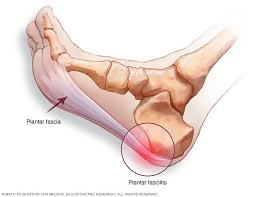 Tinea pedis, or more commonly known as athlete’s foot, is a fungal infection that affects the skin of the feet. It often starts as an itchy scaly rash between the toes or on the soles of the feet. This itching may be accompanied by stinging and burning, and if left untreated, can cause cracks and blisters to form on the skin, leading to a potential bacterial infection.
Tinea pedis, or more commonly known as athlete’s foot, is a fungal infection that affects the skin of the feet. It often starts as an itchy scaly rash between the toes or on the soles of the feet. This itching may be accompanied by stinging and burning, and if left untreated, can cause cracks and blisters to form on the skin, leading to a potential bacterial infection.
 Heel pain is a common foot problem described as pain or discomfort experienced anywhere in the rear of the foot. It is estimated that every year around two million Americans suffer from heel pain, with athletes and seniors being the usual victims. While heel pain may be prevalent in the general population, it is not in any way normal. Neglect to any heel pain symptom can lead to bigger problems such as reduced mobility and capacity to enjoy life.
Heel pain is a common foot problem described as pain or discomfort experienced anywhere in the rear of the foot. It is estimated that every year around two million Americans suffer from heel pain, with athletes and seniors being the usual victims. While heel pain may be prevalent in the general population, it is not in any way normal. Neglect to any heel pain symptom can lead to bigger problems such as reduced mobility and capacity to enjoy life.
 Poor circulation in the feet typically occurs when there is a blockage in the arteries. This common circulatory problem is known as peripheral artery disease (PAD), and it usually affects the extremities, more commonly the legs and the feet. PAD is primarily caused by atherosclerosis, or the buildup of fatty plaque in the arteries. Less common causes of PAD are blood clots in the arteries, injury to the limbs, and unusual anatomy of the muscles and ligaments.
Poor circulation in the feet typically occurs when there is a blockage in the arteries. This common circulatory problem is known as peripheral artery disease (PAD), and it usually affects the extremities, more commonly the legs and the feet. PAD is primarily caused by atherosclerosis, or the buildup of fatty plaque in the arteries. Less common causes of PAD are blood clots in the arteries, injury to the limbs, and unusual anatomy of the muscles and ligaments.
 Flat feet, also referred to as fallen arches, are a condition defined by the partial or total collapse in the arch of the foot. This means that while standing, the entire foot comes in contact with the ground, appearing completely flat, instead of being partially raised. Flat feet are a complex disorder.
Flat feet, also referred to as fallen arches, are a condition defined by the partial or total collapse in the arch of the foot. This means that while standing, the entire foot comes in contact with the ground, appearing completely flat, instead of being partially raised. Flat feet are a complex disorder.
 If you spend all day standing or walking a lot, you are at a higher risk for heel pain. Factory workers, teachers, and other occupations that are always on their feet are especially vulnerable. They would come to the clinic and complain about a stabbing pain that is usually worse in the morning. The pain normally subsides as they get up and move, but it might return after extended periods of standing or when they stand up after sitting.
If you spend all day standing or walking a lot, you are at a higher risk for heel pain. Factory workers, teachers, and other occupations that are always on their feet are especially vulnerable. They would come to the clinic and complain about a stabbing pain that is usually worse in the morning. The pain normally subsides as they get up and move, but it might return after extended periods of standing or when they stand up after sitting.
 A pedicure services are good for you and there are several clients waiting for the needed foot services. However, a nail technician is not Ingrown Toenail Specialist and many clients are dealing with ingrown toenails which is a common issue. Ingrown Toenail Treatment is not a package offered at the nail spa but the nail professionals can help prevent ingrown toenails with proper grooming techniques. But a podiatrist will offer a safe and Pain-Free Ingrown Toenail Removal.
A pedicure services are good for you and there are several clients waiting for the needed foot services. However, a nail technician is not Ingrown Toenail Specialist and many clients are dealing with ingrown toenails which is a common issue. Ingrown Toenail Treatment is not a package offered at the nail spa but the nail professionals can help prevent ingrown toenails with proper grooming techniques. But a podiatrist will offer a safe and Pain-Free Ingrown Toenail Removal.